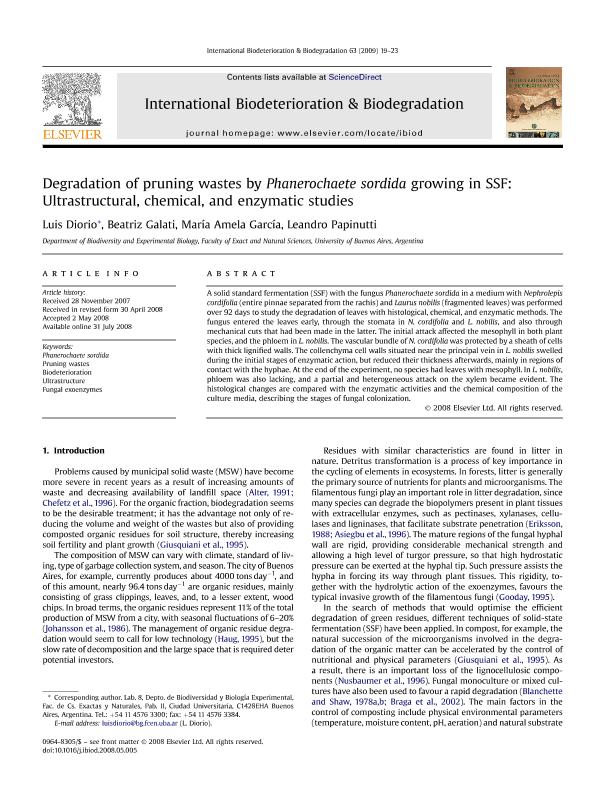Mostrar el registro sencillo del ítem
dc.contributor.author
Diorio, Luis Alberto

dc.contributor.author
Galati, Beatriz Gloria

dc.contributor.author
Amela Garcia, Maria Teresa

dc.contributor.author
Papinutti, Víctor Leandro

dc.date.available
2021-11-25T17:20:08Z
dc.date.issued
2009-01-01
dc.identifier.citation
Diorio, Luis Alberto; Galati, Beatriz Gloria; Amela Garcia, Maria Teresa; Papinutti, Víctor Leandro; Degradation of pruning wastes by Phanerochaete sordida growing in SSF: Ultrastructural, chemical, and enzymatic studies; Elsevier; International Biodeterioration and Biodegradation; 63; 1; 01-1-2009; 19-23
dc.identifier.issn
0964-8305
dc.identifier.uri
http://hdl.handle.net/11336/147427
dc.description.abstract
A solid standard fermentation (SSF) with the fungus Phanerochaete sordida in a medium with Nephrolepis cordifolia (entire pinnae separated from the rachis) and Laurus nobilis (fragmented leaves) was performed over 92 days to study the degradation of leaves with histological, chemical, and enzymatic methods. The fungus entered the leaves early, through the stomata in N. cordifolia and L. nobilis, and also through mechanical cuts that had been made in the latter. The initial attack affected the mesophyll in both plant species, and the phloem in L. nobilis. The vascular bundle of N. cordifolia was protected by a sheath of cells with thick lignified walls. The collenchyma cell walls situated near the principal vein in L. nobilis swelled during the initial stages of enzymatic action, but reduced their thickness afterwards, mainly in regions of contact with the hyphae. At the end of the experiment, no species had leaves with mesophyll. In L. nobilis, phloem was also lacking, and a partial and heterogeneous attack on the xylem became evident. The histological changes are compared with the enzymatic activities and the chemical composition of the culture media, describing the stages of fungal colonization. © 2008 Elsevier Ltd. All rights reserved.
dc.format
application/pdf
dc.language.iso
eng
dc.publisher
Elsevier

dc.rights
info:eu-repo/semantics/openAccess
dc.rights.uri
https://creativecommons.org/licenses/by-nc-sa/2.5/ar/
dc.subject
BIODETERIORATION
dc.subject
FUNGAL EXOENZYMES
dc.subject
PHANEROCHAETE SORDIDA
dc.subject
PRUNING WASTES
dc.subject
ULTRASTRUCTURE
dc.subject.classification
Ciencias de las Plantas, Botánica

dc.subject.classification
Ciencias Biológicas

dc.subject.classification
CIENCIAS NATURALES Y EXACTAS

dc.title
Degradation of pruning wastes by Phanerochaete sordida growing in SSF: Ultrastructural, chemical, and enzymatic studies
dc.type
info:eu-repo/semantics/article
dc.type
info:ar-repo/semantics/artículo
dc.type
info:eu-repo/semantics/publishedVersion
dc.date.updated
2021-10-29T15:53:20Z
dc.journal.volume
63
dc.journal.number
1
dc.journal.pagination
19-23
dc.journal.pais
Países Bajos

dc.journal.ciudad
Amsterdam
dc.description.fil
Fil: Diorio, Luis Alberto. Universidad de Buenos Aires. Facultad de Ciencias Exactas y Naturales. Departamento de Biodiversidad y Biología Experimental; Argentina
dc.description.fil
Fil: Galati, Beatriz Gloria. Universidad de Buenos Aires. Facultad de Ciencias Exactas y Naturales. Departamento de Biodiversidad y Biología Experimental; Argentina
dc.description.fil
Fil: Amela Garcia, Maria Teresa. Universidad de Buenos Aires. Facultad de Ciencias Exactas y Naturales. Departamento de Biodiversidad y Biología Experimental; Argentina. Consejo Nacional de Investigaciones Científicas y Técnicas. Oficina de Coordinación Administrativa Ciudad Universitaria. Instituto de Micología y Botánica. Universidad de Buenos Aires. Facultad de Ciencias Exactas y Naturales. Instituto de Micología y Botánica; Argentina
dc.description.fil
Fil: Papinutti, Víctor Leandro. Universidad de Buenos Aires. Facultad de Ciencias Exactas y Naturales. Departamento de Biodiversidad y Biología Experimental; Argentina. Consejo Nacional de Investigaciones Científicas y Técnicas. Oficina de Coordinación Administrativa Ciudad Universitaria. Instituto de Micología y Botánica. Universidad de Buenos Aires. Facultad de Ciencias Exactas y Naturales. Instituto de Micología y Botánica; Argentina
dc.journal.title
International Biodeterioration and Biodegradation

dc.relation.alternativeid
info:eu-repo/semantics/altIdentifier/url/https://www.sciencedirect.com/science/article/pii/S0964830508001078
dc.relation.alternativeid
info:eu-repo/semantics/altIdentifier/doi/http://dx.doi.org/10.1016/j.ibiod.2008.05.005
Archivos asociados
